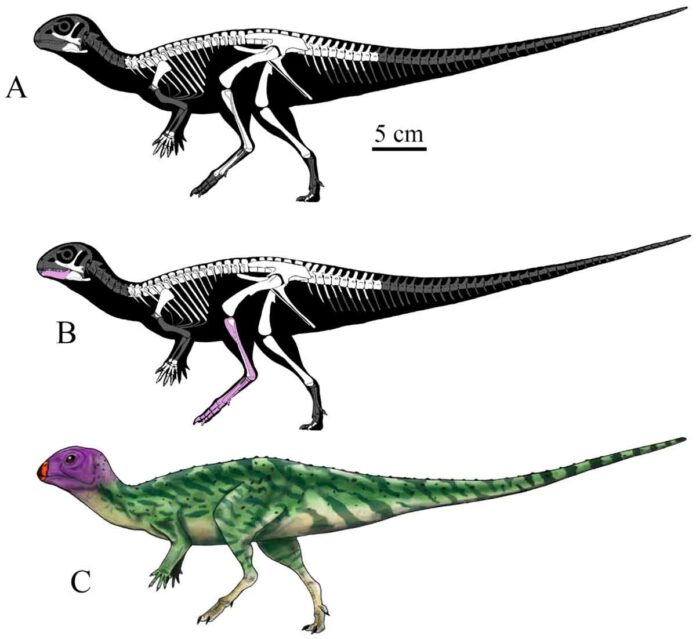A multi-institutional team of paleontologists made an astounding discovery in Thailand back in 2012 when they unearthed the fossil of a previously unknown dinosaur species.
The remarkable finding was recently published in the journal Diversity, where the group of researchers meticulously detailed the fossil’s origin, characteristics, and state of preservation.
The Unearthing of Minimocursor phunoiensis
The fossil was uncovered at a dig site in the Northern region of Thailand known as Phu Noi, specifically within the geological area called the Phu Kradung Formation.
Over the years, this site has yielded a wealth of fossils, but this particular discovery stood out to the research team due to its exceptional preservation.
The fossil, embedded in stone, was found to belong to a new dinosaur species, now identified as Minimocursor phunoiensis.
A Glimpse into the Past
The researchers were astonished by the level of detail preserved in the fossilized remains.
They described it as an “exceptionally articulate skeleton,” making it one of the most well-preserved dinosaurs ever discovered in Southeast Asia.
The dinosaur belonged to the neornithischian clade, which primarily comprised plant-eating dinosaurs.
Unraveling the Mysteries
Further analysis of the dinosaur’s characteristics revealed intriguing insights. Despite its young age at the time of death, it already possessed four limbs and primarily walked on two legs.
Its body was long and accompanied by an extended tail, while its unique beak-like snout featured a bony lump called a jugal boss.
Additionally, a distinctive ridge along its pelvis added to the creature’s allure.
Based on dating methods, the dinosaur is estimated to have lived approximately 145 to 163 million years ago and would have grown to be around 2 meters long when fully matured.
An Agile Herbivore of Its Time
The combination of physical attributes pointed to the dinosaur’s diet, suggesting it was an herbivore that likely fed on vegetation.
The researchers also deduced that it possessed remarkable speed, enabling it to swiftly evade potential predators.
The discovery was further supported by the existence of similar fossils from the same dinosaur species in the surrounding area, indicating that Minimocursor phunoiensis was once a prevalent species in its ecosystem.
Ongoing Exploration
As the research team continues to study the fossil, they have identified some bones that require further processing, including the skull.
Once these elements are fully analyzed, the scientists anticipate uncovering even more valuable information about this extraordinary dinosaur and its place in the prehistoric world.
In conclusion, the discovery of Minimocursor phunoiensis adds an important piece to the puzzle of understanding the ancient world of dinosaurs.
With its unparalleled level of preservation, this new species sheds light on the diverse ecosystems that thrived millions of years ago in what is now Thailand.
As the research progresses, more exciting revelations are sure to follow, providing us with a deeper appreciation of the fascinating creatures that once roamed the Earth.
FAQs
The discovery of Minimocursor phunoiensis is significant because it represents a previously unknown dinosaur species that is exceptionally well-preserved. The level of detail in the fossilized remains is remarkable, providing valuable insights into the dinosaur’s characteristics and its place in the ecosystem.
The fossil was uncovered at a dig site in Phu Noi, located in Northern Thailand. The geological area where it was found is known as the Phu Kradung Formation, which has been a rich source of fossils over the years.
Minimocursor phunoiensis belongs to the neornithischian clade, a group of plant-eating dinosaurs. Its physical characteristics suggest that it was an herbivore that likely fed on vegetation.
The dinosaur fossil has been dated to approximately 145 to 163 million years ago, providing a glimpse into the distant past and the world these ancient creatures inhabited.
When fully grown, Minimocursor phunoiensis would have been approximately 2 meters long. Despite its young age at the time of death, the fossilized remains already exhibited four limbs and a primarily bipedal locomotion.
Yes, the researchers noted that other fossils of the same type of dinosaur have been found in the same general area, indicating that Minimocursor phunoiensis was a relatively common species in its ancient ecosystem.
More information: Diversity (2023). DOI: 10.3390/d15070851

